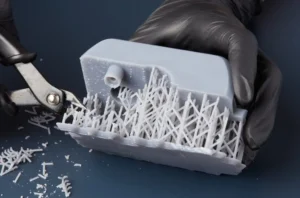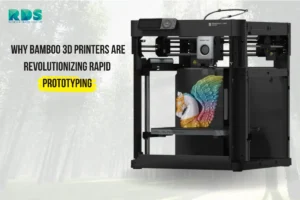The Critical Decision: Why Your Resin Choice Makes or Breaks Detail Work
Have you ever held a perfectly printed SLA prototype with details so fine you can barely believe they were 3D printed? Or perhaps you’ve experienced the opposite—a prototype with lost details, warped features, or brittleness that makes it useless for testing. The difference often comes down to one critical factor: the resin you choose.
For designers, engineers, and manufacturers who need immaculate prototypes, selecting the right SLA resin can feel overwhelming. With dozens of formulations on the market in 2025, each promising superior performance, how do you cut through the marketing hype to find the perfect material for your specific application?
At RDS, we’ve tested countless resins across thousands of high-detail projects. We’ve learned—sometimes the hard way—which resins deliver on their promises and which fall short. In this comprehensive guide, we’ll share the expertise we’ve developed through years of professional printing services to help you make informed decisions for your next precision prototype.
Understanding SLA Technology: The Foundation of High-Detail Printing
How SLA Works: The Science Behind the Detail
Stereolithography (SLA) remains the gold standard for high-detail 3D printing in 2025. Before diving into specific resins, it’s essential to understand why this technology excels at capturing fine details.
SLA printing works through a process called photopolymerization:
- A tank is filled with liquid photopolymer resin
- A UV laser or LED light source selectively cures specific areas
- The build platform raises incrementally after each layer solidifies
- The process repeats until the complete object emerges
According to the National Institute of Standards and Technology (NIST), SLA can achieve feature resolutions as small as 25-100 microns, making it ideal for applications requiring extreme precision. This resolution capability far exceeds what’s possible with FDM/FFF technology, which typically achieves 200-400 micron features at best.
SLA vs. FDM: When Detail Matters
While our 3D printing services include both technologies, the differences are significant:
| Aspect | SLA | FDM |
| Detail resolution | 25-100 microns | 200-400 microns |
| Surface finish | Smooth off the printer | Visible layer lines |
| Feature precision | Excellent for small details | Limited by nozzle size |
| Material properties | Varies by resin | Limited by thermoplastics |
| Post-processing | Required (washing/curing) | Optional |
For high-detail prototypes like architectural models, jewelry designs, dental applications, or intricate mechanical assemblies, SLA’s superior resolution makes it the clear choice. Our product design team regularly chooses SLA for prototypes where communicating fine details to clients is paramount.
Resin Properties: The Critical Factors for High-Detail Work
Key Properties to Consider
When evaluating resins for detail work, these properties deserve your closest attention:
Resolution Capability
- What it means: The minimum feature size the resin can reliably reproduce
- How it’s measured: Usually in microns (smaller = better)
- Why it matters: Determines the finest details you can achieve
- Typical range: 25-100 microns for high-detail resins
According to ASTM standards for additive manufacturing, resolution isn’t just a function of the printer but is heavily influenced by resin formulation. Some resins will consistently outperform others on the same machine.
Detail Retention
- What it means: How accurately the cured resin maintains the designed dimensions
- How it’s measured: Deviation from CAD model dimensions
- Why it matters: Prevents loss of critical features during printing and curing
- Best performers: Engineering resins with minimal shrinkage (under 1%)
Our testing at RDS shows that cheap generic resins often exhibit shrinkage of 3-5%, making them unsuitable for precision work.
Viscosity
- What it means: The resin’s resistance to flow
- How it’s measured: Centipoise (cP)
- Why it matters: Affects resin movement between layers and detail formation
- Optimal range: 50-200 cP for most high-detail applications
Resins that are too viscous struggle to flow into tight spaces, while those that are too thin may not maintain fine features during the build process.
Shore Hardness
- What it means: Material rigidity after curing
- How it’s measured: Shore D scale for rigid materials, Shore A for flexible ones
- Why it matters: Determines if delicate features will bend or break
- Typical range: 60D-85D for standard rigid resins
When our reverse engineering team reproduces complex parts with fine features, material hardness becomes critical for ensuring those features survive handling and testing.
Curing Requirements
- What it means: The light and/or heat needed to fully solidify the resin
- How it’s measured: Wavelength (nm) and energy dosage
- Why it matters: Affects detail crispness and material properties
- Standard: 405nm for most consumer/prosumer SLA printers
Inadequate post-curing is a leading cause of prototype failure, as uncured resin inside the part gradually deforms the outer surfaces.
Common Resin Categories and Their Detail Capabilities
The market in 2025 offers several categories of SLA resins, each with different strengths:
Standard Resins
- Detail capability: Good (50-100 microns)
- Durability: Moderate
- Key applications: Visual prototypes, general modeling
- Price range: $40-80/liter
- Pros: Cost-effective, good all-around performance
- Cons: Limited mechanical properties, moderate detail retention
Standard resins are the workhorses of SLA printing but may not capture the finest details in complex models.
Engineering Resins
- Detail capability: Excellent (25-50 microns)
- Durability: High
- Key applications: Functional prototypes, end-use parts
- Price range: $100-300/liter
- Pros: Superior mechanical properties, excellent detail retention
- Cons: Higher cost, may require specialized curing equipment
Engineering resins often contain ceramic particles or special polymers that enhance dimensional stability during curing, making them ideal for high-precision parts.
Dental Resins
- Detail capability: Superior (25 microns or better)
- Durability: Varies by type
- Key applications: Dental models, surgical guides, aligners
- Price range: $150-400/liter
- Pros: Biocompatible options, exceptional detail reproduction
- Cons: Specialized formulations, high cost
According to the FDA’s guidance on 3D printing medical devices, dental resins undergo rigorous testing for biocompatibility, making many of them excellent choices for any high-detail application, not just dental work.
Jewelry Casting Resins
- Detail capability: Extraordinary (25 microns or better)
- Durability: Low (designed to burn out cleanly)
- Key applications: Jewelry prototypes, casting patterns
- Price range: $100-200/liter
- Pros: Zero ash residue, captures microscopic details
- Cons: Brittle, limited functional testing applications
We’ve found jewelry resins perform exceptionally well for architectural models and similar applications where ultra-fine detail matters more than strength.
Matching Resin to Application: A Systematic Approach
Questions to Define Your Needs
Before selecting a resin, answer these essential questions:
- What’s the smallest feature size in your design?
- Under 0.5mm: Requires high-resolution resin
- Over 0.5mm: Standard resins may suffice
- Will the prototype undergo functional testing?
- Yes: Prioritize engineering resins with appropriate mechanical properties
- No: Visual prototyping resins may be sufficient
- What environmental conditions will the prototype experience?
- UV exposure: Requires UV-stable formulation
- Heat exposure: Check heat deflection temperature (HDT) ratings
- Chemical exposure: Review chemical resistance charts
- What’s your budget constraint?
- High: Full range of options available
- Limited: Consider if detail requirements can be relaxed in some areas
Based on thousands of projects at our 3D printing service center, these questions will narrow your options to a manageable shortlist.
Application-Specific Recommendations
Based on our extensive experience at RDS, here are our top recommendations for specific high-detail applications:
Architectural Models
- Best resin types: High-detail standard or rigid engineering resins
- Key properties: Low shrinkage, good rigidity, white or clear base color
- Special considerations: Often requires being left unpainted, so color consistency matters
For our architectural clients, we typically recommend resins with Shore D hardness above 75 to ensure thin walls and delicate features remain straight and true over time.
Medical Prototypes
- Best resin types: Biocompatible or dental resins
- Key properties: High accuracy, appropriate compliance for tissue simulation
- Special considerations: May require biocompatibility certifications
When our product design team works on medical devices, they often start with dental resins even for non-dental applications due to their exceptional detail capabilities.
Consumer Product Prototypes
- Best resin types: Engineering resins that mimic end-use materials
- Key properties: Physical properties similar to production materials
- Special considerations: Often needs to withstand repeated handling
The America Makes innovation institute recommends selecting resins that approximate the final production material’s properties for the most valuable prototype testing.
Jewelry and Artistic Models
- Best resin types: Jewelry casting resins or high-detail standard resins
- Key properties: Exceptional small feature reproduction, smooth surface finish
- Special considerations: Often needs to be photographed, so clarity or consistent color matters
Our specialists have found that jewelers’ requirements for detail are among the most demanding of any industry, making these resins excellent for any ultra-high detail work.
Optimizing Printer Settings for Your Chosen Resin
Critical Settings That Affect Detail
Once you’ve selected your resin, dialing in these printer settings is crucial:
Layer Height
- What it is: The thickness of each printed layer
- Impact on detail: Thinner layers = finer vertical resolution but longer print times
- Typical range for high detail: 0.025-0.05mm
- Our recommendation: Start at 0.05mm and reduce only if necessary
Our 3D scanning specialists can capture details at 0.025mm resolution, but we’ve found that most high-detail prototypes print beautifully at 0.05mm, balancing detail and print time.
Exposure Time
- What it is: How long each layer is exposed to UV light
- Impact on detail: Shorter times may improve detail but risk incomplete curing
- Finding the optimum: Requires systematic calibration
- Our approach: Exposure calibration test before every critical print
According to research from NIST, overexposure is the leading cause of lost detail in SLA printing, causing “light bleed” that fills in fine features.
Support Structures
- What they are: Temporary structures that hold the model during printing
- Impact on detail: Can mar surfaces and interfere with fine features
- Optimization approach: Strategic placement and size minimization
- Advanced technique: Custom support structures for critical areas
We’ve developed proprietary support strategies that minimize contact points while ensuring build success.
Print Orientation: The Overlooked Detail-Killer
Print orientation dramatically affects detail reproduction:
- Orienting curved surfaces: Align to minimize “stair-stepping” effect
- Critical features: Position to avoid support connections
- Overhangs and islands: Angle to minimize unsupported areas
- Detail prioritization: Orient your most important details for optimal resolution
One counterintuitive technique our technicians use: sometimes printing at an angle (rather than flat or vertical) provides the best detail reproduction, especially for cylindrical features.
Post-Processing: Preserving Detail After Printing
Washing Techniques for High-Detail Parts
Improper washing can destroy fine details before you even see them:
- Recommended solvents: Isopropyl alcohol (90%+) or specialized resin cleaners
- Washing time: 3-5 minutes (longer can damage details)
- Ultrasonic cleaners: Effective but must be used cautiously on delicate features
- Compressed air: Useful for clearing resin from tiny crevices
- Multiple baths: Use progressively cleaner solvent for best results
A study from Pennsylvania State University’s CIMP-3D center found that up to 30% of detail loss occurs during the washing phase, making this step just as critical as the printing itself.
Curing Methodology: The Final Detail-Preservation Step
Proper curing solidifies detail preservation:
- UV wavelength: Match to your resin’s requirements (typically 395-405nm)
- Curing time: Follow manufacturer recommendations (typically 5-60 minutes)
- Temperature control: Many resins benefit from heat during curing (60-80°C)
- Oxygen-free environment: Consider water submersion or nitrogen chamber curing
- Rotating/flipping: Ensure uniform exposure on all surfaces
Our 3D printing service uses programmable curing cycles that gradually increase UV intensity to minimize warping while ensuring complete curing.
Surface Finishing Techniques That Preserve Detail
When further finishing is needed:
- Hand sanding: Use progressively finer grits (start at 600+)
- Vapor smoothing: Limited applicability for resins, but can work with some types
- Coating/painting: Thin layers to avoid filling fine details
- Polishing compounds: Specialty products for resin polishing
One technique our detail specialists use: applying a vacuum-formed clear film over the model during final curing to create a glass-smooth finish without losing detail.
Real-World Testing: How We Evaluate Resins at RDS
We employ a systematic approach to resin evaluation:
- Standardized test prints: We use calibrated test models with features ranging from 0.1mm to 2mm
- Dimensional analysis: 3D scanning the print and comparing to the original CAD file
- Mechanical testing: Testing appropriate properties (tensile strength, elongation, etc.)
- Aging tests: Evaluating how properties change over time under different conditions
- Application-specific testing: Custom evaluations based on the intended use
This rigorous approach ensures we recommend only resins that will deliver consistent results for our clients.
Cost Considerations: Balancing Budget and Detail Requirements
High-detail resins command premium prices, but there are ways to optimize:
- Mixed-detail approach: Use high-detail resin only for critical areas through strategic model splitting
- Hollowing: Reduce material consumption for larger prototypes
- Bulk purchasing: Many manufacturers offer significant discounts for larger quantities
- Testing programs: Some manufacturers offer sample programs for professional users
According to the Journal of Manufacturing Technology Management, material costs typically represent 30-40% of total SLA prototype costs, making resin selection a significant budget consideration.
Case Studies: Resin Selection in Action
Medical Device Prototype: When Detail Saves Lives
One of our product design clients needed to prototype a minimally invasive surgical tool with sub-millimeter features:
- Challenge: Features as small as 0.3mm that needed to maintain exact dimensions
- Resin selection: Dental surgical guide resin (biocompatible)
- Result: Successful prototype that surgeons could evaluate in realistic scenarios
- Key insight: Medical-grade resins often outperform standard resins even for non-medical applications
Architectural Model: Communicating Design Intent
Our architectural visualization team needed to create a 1:200 scale model of a complex building design:
- Challenge: Representing delicate facade elements only 0.15mm thick
- Resin selection: Jewelry casting resin (non-brittle formulation)
- Result: Model captured every design nuance, allowing stakeholders to evaluate the design accurately
- Key insight: Resins designed for casting often excel at reproducing extremely fine details
Looking Forward: Emerging Resin Technologies for 2025 and Beyond
The SLA resin landscape continues to evolve rapidly:
- Composite resins: Incorporating ceramic, metal, or carbon particles for enhanced properties
- Direct-to-production resins: Engineering materials suitable for end-use parts
- Self-healing formulations: Resins that can repair minor damage through UV exposure
- Eco-friendly options: Bio-based resins with reduced environmental impact
Research from the Massachusetts Institute of Technology indicates that specialized resin development is accelerating, with properties approaching injection-molded plastics in some applications.
Conclusion: Making Your Final Selection
Choosing the right SLA resin for high-detail prototypes requires balancing numerous factors, from technical specifications to budget constraints. By understanding the fundamental properties that affect detail reproduction and following the systematic approach outlined in this guide, you can make confident decisions that deliver exceptional results.
Remember that resin selection is only one part of the equation. Printer settings, post-processing techniques, and design optimization all play crucial roles in achieving the finest details possible.
Whether you’re printing architectural models, consumer product prototypes, medical devices, or artistic pieces, the right resin makes all the difference between a prototype that merely suggests your design and one that brings it to life with perfect clarity.
Are you working on a high-detail prototype but unsure which resin would best capture your vision? Our team at RDS specializes in matching materials to applications based on real-world testing and years of experience across industries. What detail challenges are you facing in your current project? Share in the comments below or reach out to discuss how our 3D printing services can help bring your detailed concepts to reality!
This article was crafted by the additive manufacturing specialists at RDS, where we transform concepts into reality through advanced 3D scanning, product design, and professional 3D printing services. Visit our blog for more insights on additive manufacturing technologies.





